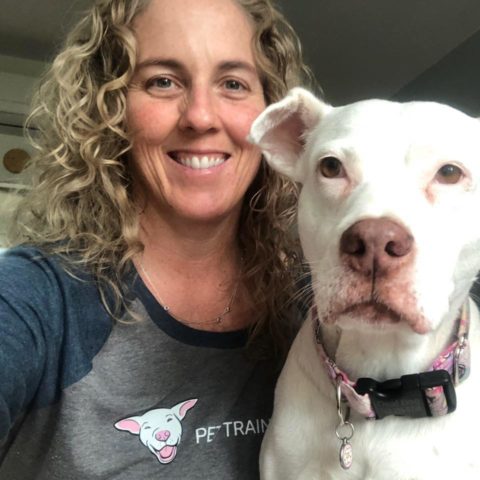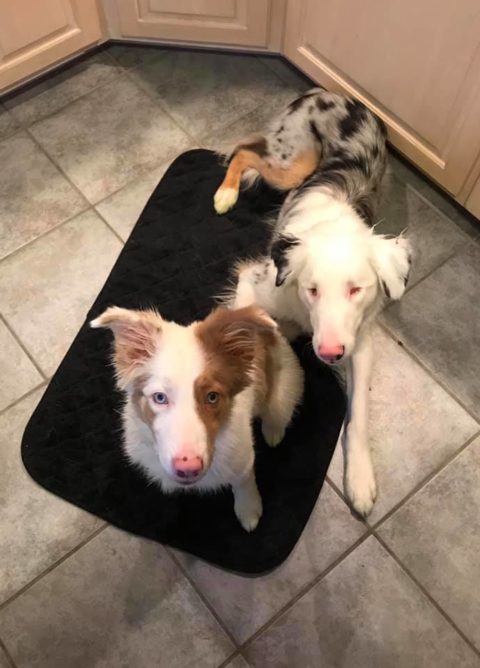Getting Help with Separation Anxiety in Dogs

One of the animal behavior questions I get asked most often is, “How can you help with separation anxiety in dogs?” Separation Anxiety in dogs is one of the most common behavior problems. If your dog is distraught, appears nervous, or shows other signs of anxiety when you leave your home, or he does not have access to you, there are many ways you can help your dog be more at ease when left alone.
If you are trying to resolve separation anxiety in dogs, how can positive reinforcement training help?
Training with Positive reinforcement is when we add something to the situation in the hopes of increasing or having behavior repeat. So an example would be if, let’s say a dog was to lay down, and we wanted to encourage that behavior. If we wanted to see more instances of the dog laying down we might give the dog a treat each time the dog performed this behavior. We’d know if the treat was reinforcing to the dog if the laying down behavior was repeated.
How do you know if your dog has separation anxiety?
If you’re questioning whether or not your dog may have separation anxiety, which is similar to a panic attack in humans, the first steps are to rule out other possibilities. As with any time we have a behavior issue, we want to eliminate any possible medical cause for the behavior. So, a vet check is step one.
Then, if we have a dog that is vocalizing a lot (aka, excessive barking, howling, whining) or eliminating (defecating or urinating) in the house or destroying things (chewing furniture or ripping curtains), we want to make sure that these behaviors are not attributed to something else. For example, if the dog is barking a lot, we want to make sure that it’s not attention seeking behavior. If the dog is going to the bathroom in the house, we want to make sure that the dog has understood where to go to the bathroom. In other words, we want to be sure it’s not a house-training issue. If the dog is being destructive, we would want to make sure that it’s not a boredom problem.
Often with puppies, too, we are specifically trying to rule out other choices. We want to make sure that the problem is not related to the dog being a puppy. For example, we would want to differentiate between puppy chewing behavior and chewing behavior caused by the underlying issue–anxiety.
When working on separation anxiety in dogs, why you should not punish the behavior?
Anytime that we have unwanted behavior, we want to avoid punishment. We don’t want to try to stop or decrease the behavior. Instead, we first want to understand why the behavior is occurring. Anytime we have an unwanted behavior, step one is to discern why the problem behavior is there. What is motivating the behavior to continue to repeat? Step one also would involve a veterinarian check. We want to rule out the fact that the behavior is present, potentially, because of some medical reason.
Is the dog uncomfortable? Is the dog suffering in some way? Just like with a person if you were in pain, you might act more cranky than if you’re feeling happy. Thus, ruling out a potential medical reason for the problem would be the spot to start. And if the dog were suffering, we certainly wouldn’t want to punish that behavior.
After ruling out a medical reason for the behavior, we would also want to look at other possibilities. For example, if the dog was barking a lot, is the barking due to something that is bothering them? Is it attention seeking behavior? If the dog were eliminating (urinating or defecating) in the house, we would want to make sure that this wasn’t a house-training issue. Punishing a dog for eliminating in the home could cause them to hide and continue to do the behavior.
If the dog was destructive, again, punishing the behavior could result in apathy, aggression, escape-avoidance, or generalized fear. Nothing that we want in any animal, but in particular, if we already have a dog that’s fearful and anxious, with regard to the dog’s suffering from separation anxiety.
What to do if you arrive home to a big mess?
If you arrive home, and you have a big mess, the first thing that you’ll want to do is ignore the situation completely. Because if you haven’t caught the dog in the act, then the dog is not associating your behavior with the mess. Instead, the dog is saying, “Wow, my person came home, and they look really upset. I have no idea why,” which is very confusing.
So, although a lot of times, people may say the dog looks guilty for “bad behavior,” generally that is what’s called appeasement behavior. The dog is looking at you. Perhaps you have a stern, angry face. Maybe you’re upset by what you see, and the dog is reacting to your behavior, rather than feeling, “guilty” in that situation.
To recap, if you come home to a mess you want to clean it up and maybe see if you can puzzle out what’s happened. I would suggest trying to watch remotely. You could do that with a camera. You could also do that by connecting your smartphone and your computer to do either a FaceTime or a Skype to Skype, or a Zoom to Zoom session. See if you can get some eyes on what’s going when you’re not there.
When working with separation anxiety in dogs, how can positive reinforcement training help to build trust and confidence?
Anytime we use positive reinforcement training, it helps to work on the human-animal bond. It helps to build confidence and trust. When it comes to dog with separation anxiety there are other behaviors outside of a specific desensitization and counterconditioning protocol that can aid in the overall relationship.
Other behaviors include options like a “non-follow” or a “settle” behavior. For example, I had a client I was working with on separation anxiety and each time the people moved, the dog began jumping and nipping. We needed to separately address these behaviors by reinforcing an incompatible behavior such as “four paws on the floor.” We did this by using positive reinforcement to mark and reinforce the dog’s paws on the ground. This training complemented our separation anxiety protocol work using desensitization.
Why does my dog experience separation anxiety when I leave the house but is fine in other instances?
With separation anxiety, like many behaviors, dogs don’t generalize well. Too, the answer is often, “it depends.” I’ve had clients where dogs were comfortable at somebody else’s home alone, but at their own home, they panicked and had excessive anxiety. A dog may be okay at home and then they begin to show signs of separation anxiety. Often, there is something in the environment that has changed which prompts the behaviors associated with separation anxiety.
Sometimes dogs are comfortable in one setting but not in another. Again, it’s up to the individual dog. It’s dependent upon the context. There’s no right or wrong answer here but basically, just like Dr. Susan Friedman says, “It’s a study of one.” We want to look at the individual dog, and the individual environment and see where the dog actually can feel relaxed and calm, or not. Then we work from that spot to help dogs with separation anxiety to feel more comfortable when home alone.
What behaviors can be shaped that help with separation anxiety in dogs?
When working on dogs suffering from separation anxiety we can also work on training a number of behaviors in combination with a specific separation anxiety protocol. Behaviors such as “settle” or “station in one spot–on a mat or dog bed” are examples of complementary calm behaviors. And we can teach the dog to relax, again, not in the context of you departing, but separate. Then, eventually, that can help to overlap and find its way into a separation anxiety protocol.
We can also teach four paws on the floor. Frequently I’ve had clients where, when they’re about to depart, and we have a dog who’s suffering from separation anxiety, some of that anxiety is demonstrated in jumping up at the person as they’re trying to leave. So, a separate behavior that you can work on, unique but again complementing the separation anxiety protocol, would be reinforcing four paws on the floor.
Additionally, you could teach other confidence-building behaviors. Things like a hand target, which can help a dog to recognize, “I can get reinforced for this behavior. If I choose not to do this behavior, nothing bad or scary happens. But, if I do choose to do this behavior, opportunities for reinforcement exist.” Teaching things like a hand target, settle, four paws on the floor–again, any behaviors that you can reinforce and continue to build up that trust and human/animal bond outside of a specific desensitization protocol for separation anxiety– can be beneficial.
When trying to resolve separation anxiety in dogs, should you put your pup in a crate?
If your dog’s suffering from separation anxiety a lot of times, anecdotal information will suggest crating the dog, or leaving them with a long-lasting food puzzle like a stuffed KONG toy. Both crates and KONGs have places in training and behavior modification. However we often might find confinement issues comorbidly with dogs suffering from separation anxiety. Meaning that now, not only do we have a dog who’s anxious about being alone at home but they’re doubly anxious because they’re in a confined space without the ability to exit.
Also, if we’re crating the dog because of destructive behavior or inappropriate elimination, what we want to do is go back and look at the underlying cause, which in this case may be anxiety. We address the root of the issue, which would then alleviate the reason for the crating.
In the case of a KONG, or another type of long-lasting food puzzle, with separation anxiety, frequently what we might see is a dog who either has anorexia, which in dogs is defined as anxiety and not eating. We leave an otherwise high-value food puzzle, and the dog doesn’t touch it while he’s home alone. Or, we have a dog who scoffed it back, and after about 10 or 15 minutes, we see the symptoms re-emerge. This happens because we haven’t addressed the underlying issue.
That’s not to say that food puzzles and KONGs can’t have a place if we’re also using a desensitization protocol. But by themselves, usually, they don’t lead to the resolution that we’re looking for.
Helping separation anxiety in dogs with positive reinforcement training.
The first thing that we want to look at, as with any type of behavior modification, is management. We want to manage the situation so that the dog doesn’t continue to rehearse the unwanted behavior. In the case of separation anxiety, unwanted behavior happens when the dog is alone. Therefore, what we want to do is suspend absences, outside of a specific protocol. While at first the idea of suspending absences might sound overwhelming, there are many resources which talk about how to accomplish this. The reason suspending absences is so important is because otherwise, it’s kind of like taking three steps forward, and five backward.
This is because there is no way to communicate to the dog, “I’m only leaving for two minutes, this time.”Our behavior of suspending absences allows the dog to gradually start to feel more relaxed about not needing to be on edge because a departure may be imminent at any moment.
Suspending absences and pre-departure cues
Suspending absences would be step number one after ruling out any medical issues. The next step would be to look at pre-departure cues. Pre-departure cues, which we abbreviate PDQs, are things like, the obvious ones such as shoes and car keys. They may be a purse or a jacket, but they can also be things like filling your to-go coffee, filling up the dog’s water bowl, or starting to put your dog in a crate with some treats.
The dogs can generalize, sometimes back to even brushing your teeth. For example, I had a client whose dog, upon opening his sock drawer, began to show signs of feeling anxious and recognized that a departure was soon going to happen. Identifying those pre-departure cues is key. When we work on a separation anxiety protocol for dogs, using desensitization, the start would be to remove the pre-departure cues and then start to add them in slowly, one at a time.
Some departure cues are more relevant
The reason we would do that is because some cues may be more relevant to that dog. Some dogs may, for example, not react at all when you put your shoes on. But, if you pick up the keys, that causes an immediate sense of panic. In those cases, we maybe be slow down and/or work on desensitization or sometimes even counter conditioning. This means pairing the experience with something that the dog values to create a positive association. We do this in order to help that dog to relax more in response to that particular pre-departure cue.
Desensitization protocol
Then we work on a specific protocol of desensitization. It generally takes about 30 minutes a day. We work on a variety of stuff geared specifically to the individual dog with changing criteria, depending on the dog’s response. Basically, we’re looking to help the dog not to react to your movements which indicate departure. These might be things like standing up, walking to the door, touching the doorknob, and then coming back and sitting down. If the dog responds to that step with a significant response, or significant reaction with his body language that would indicate anxiety, then we may need to repeat that step or even break down the criteria further. Maybe we have to walk halfway to the door, for example.
Whereas, if the dog is relaxed during that step of the exercise, then we might be able to take the next push in our criteria; a next step to walk to the door, open the door three inches, or halfway, close the door again, come back and sit down. Gradually, over time, using a specific desensitization protocol, we can help the dog to feel, “Ho hum,” “That’s boring,” and to feel not anxious anymore about those types of movements.
Eventually, with the pre-departure cues incorporated as well, and eventually, during the overall departure and then, adding duration with that departure, we arrive at a situation where we can have a calm dog relaxed at home for a longer period of time. This allows the people in the family to go about their normal daily life activities.
Separation Anxiety in Dogs Series Episode 2 – Getting Help with Separation Anxiety in Dogs
Get relief from the desolation of your dog’s separation anxiety.
 Have you been thwarted by previous training attempts? You need a highly-trained specialist—an expert who devotes her days to resolving dog desolation distress.
Have you been thwarted by previous training attempts? You need a highly-trained specialist—an expert who devotes her days to resolving dog desolation distress.
I offer a distinctively successful approach to separation anxiety issues with daily guidance and extensive encouragement. If you and your dog are suffering from your dog’s separation anxiety, sign up for my Separation Anxiety Program. I’ll help dissolve your despair.



